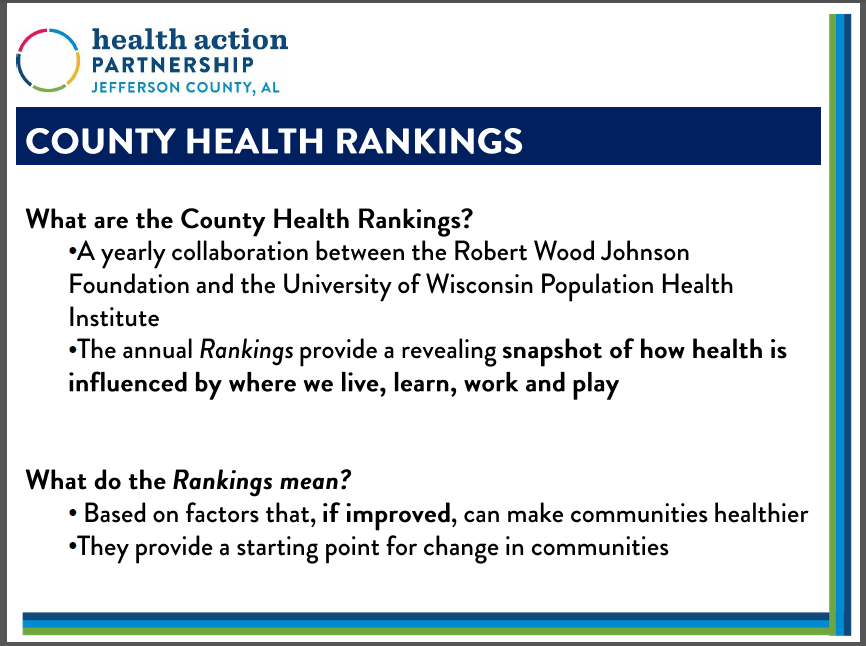Central Alabama counties continue to make improvements in community health, according to the annual County Health Rankings recently released by the Robert Wood Johnson Foundation (RWJF) and the University of Wisconsin Population Health Institute (UWPHI).
 The rankings take a comprehensive look at the factors that influence the health of a community. These include statistics typically associated with health, such as smoking and physical activity rates, as well as social and environmental factors that have also proven to have a substantial impact on community health, such as graduation, employment and stable housing rates.
The rankings take a comprehensive look at the factors that influence the health of a community. These include statistics typically associated with health, such as smoking and physical activity rates, as well as social and environmental factors that have also proven to have a substantial impact on community health, such as graduation, employment and stable housing rates.
Among all counties in Alabama, Jefferson County is ranked #8 in health factors, slightly down from #7 in last year’s rankings. St. Clair County now ranks #15, Blount County ranks #16 and Walker County ranks #24, all of which represent improvements from 2018.
Shelby County remains in the #1 spot as the healthiest county in Alabama.
Efforts are underway to further improve the rankings of counties across the region. The Bold Goals Coalition is working to ensure all Central Alabama counties will be ranked in the top-10 healthiest counties in Alabama by 2025. The Bold Goals Coalition is 200 organizations solving big community problems by aligning partners, resources and agendas.
“The Bold Goals Coalition is committed to finding collaborative, innovative solutions to some of Central Alabama’s most pressing problems,” said Drew Langloh, President & CEO of United Way of Central Alabama, which provides administrative support for the Coalition. “Our approach continues to show measurable results, and that’s illustrated in the overall improvements in the rankings over the past few years.”
The work of the Bold Goals Coalition includes mobilizing partners throughout the region to improve physical environments in a variety of ways. Such projects include adding more sidewalks and recreational spaces where people live, improving regional systems to enhance access to healthcare and mental health services and increasing food access for children through summer and after-school programs.
The Coalition is working in collaboration with the Jefferson County and Walker County Health Action Partnerships to not only improve the environments where people live, but also to address the broader health disparities that exist in the region.
“The rankings illuminate health disparities across Central Alabama,” said Dr. Monica Baskin, professor and Vice Chair of Culture and Diversity in the Department of Medicine and Associate Director for Community Outreach and Engagement at the O’Neal Comprehensive Cancer Center at the University of Alabama at Birmingham. Dr. Baskin is also Chair of the Jefferson County Health Action Partnership. “A core theme of our work through the Health Action Partnership,” she said, “is to develop and promote strategies that address the root causes of these disparities, not only at the regional level, but also at the community and neighborhood level.”
While the five-county Central Alabama region is home to Shelby County, which has been ranked as Alabama’s healthiest county since the rankings were first released in 2011, it also includes Walker County, which was ranked as the unhealthiest county in the state in 2015. Walker County, however, has shown consistent improvement since then and coinciding with the Walker County Health Action Partnership having begun work on particular issues of concern in the county.
“I am heartened that our overall health factors climbed from 31st to 24th,” said Paul Kennedy, President of the Walker Area Community Foundation and Chair of the Walker County Health Action Partnership. “We need to continue to reinforce the progress that we have made and not quit on those persistent factors that continue to drag us down in the rankings. We will spend more time in 2019 focused on heart disease, obesity, smoking and overdose deaths – all factors in our too-high rate of premature death. If we can move these few key factors, we can skyrocket up the rankings and become the healthier community that we strive to be.”
According to Ericka Burroughs-Girardi, an Action Learning Coach with the County Health Rankings program, changes in community health are heavily influenced by policy and systems changes that can take years to have an impact.
“Jefferson County has enacted a number of policies that influence health,” Burroughs-Girardi said. “Moves to increase green space, promote fitness, increase the supply of affordable housing and combat food deserts ultimately mean people will live longer, better lives. Jefferson County is a great example of a county where we’re starting to see change come about.”
Despite the improvements in many health categories, there is still work to be done to improve the factors that influence the health of a community, such as graduation rates, employment opportunities and children in poverty.
“We like to look at the County Health Rankings each year to see the trends, and to look for opportunities for long-term improvements in health outcomes in our county,” said Mark Wilson, M.D., Health Officer for the Jefferson County Department of Health. “One of the main benefits of the rankings is that they help us understand the impact of social determinants of health – things like income, education, transportation and housing. They point to the fact that neither the health department nor providers of healthcare are alone sufficient to achieve optimal community health. Local governments and other governmental agencies, policymakers, nonprofit organizations, the educational system and the business community all have a role to play.”
The Bold Goals Coalition is 200 organizations solving big community problems by aligning partners, resources and agendas.

